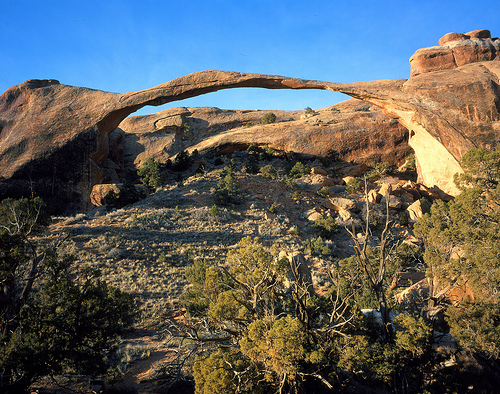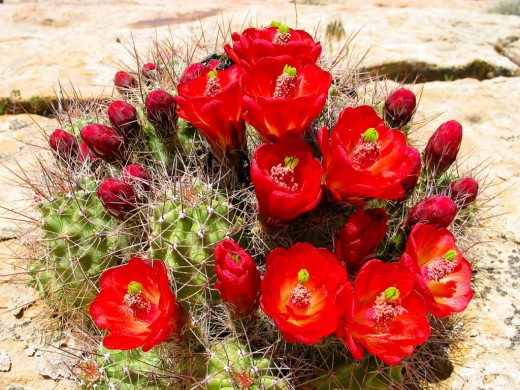Last week, after an “Auntie Jessica” visit to San Francisco, I visited the Arches National Park in Moab, Utah, with my friend Stefanie. It had been years since I’d spent any time in a desert environment. Watching out the car window as we drove south from Salt Lake City, I saw the sharp, snow-capped mountains and lush greens gradually give way to myriad shades of tan, red, and shrubby sage green. The dry heat was a contrast to the California ocean breezes; both climates were welcome changes from Nashville’s sticky humidity.
As I adjusted to the time zone, elevation, and temperature, I absorbed the landscape’s grandeur. Immersing myself in the breathtakingly unique landscape of the Arches for a couple days was as invigorating as I hoped it would be. I’d never seen anything quite like the arches and the rock formations that dominate the horizon there. The expansiveness of the scenery stretched my thoughts and seemed to summon my whole being to rapt attention.
 Delicate Arch (National Park Service Photo)
Delicate Arch (National Park Service Photo)
Beyond how visually stunning they are, the arches bear witness to the long, gradual changes wrought over time by the forces of water and wind. Some 65 million years ago, deep shifts in the mile-thick rock and the mile-thick salt deposits below it caused areas of rock to jut up or sink down dramatically. The raining and freezing and blowing to which the emerging rock was subjected eventually created “fins” of rock, many of which stand intact today, along with towers of rock capped by precarious-looking massive boulders. The arches themselves are not formed by a constant force like flowing water, but rather result when enough of the “glue” of the sandstone fins erodes away as time and the elements slowly and repeatedly combine forces; the bottom falls out and an arch remains. The arches vary — there are over 2,000 of them in the Park currently — some are thick and sturdy, others improbably fragile, like the famed Delicate Arch or the 306-foot wide Landscape Arch.
 Landscape Arch (National Park Service Photo)
Landscape Arch (National Park Service Photo)
It’s tempting to think that the scenery is static, that what we see today is the endpoint of the 300-odd million years’ worth of changes, but in truth it’s dynamic. Occasional drastic and sudden changes, like the thunderous fall of a huge slab from the Landscape Arch in September 1991, are a reminder that the arches are continuing to evolve. New ones are formed; others weaken and collapse. The graceful arch that you and all the other tourists are photographing may not be there in five, ten, or twenty years.
The other seemingly static but actually quite dynamic component of the landscape is the soil. Or more precisely, the biological soil crust. It looks like clumps of brown dirt scattered across the rock, but it’s made up of a rich cocktail of cyanobacteria, algae, moss, lichens, and microfungi that allows soil to resist erosion and cling to the rock enough for things to grow. It helps plants optimize what little water remains available between rainfalls. It’s a complex and sophisticated system unto itself, one that has evolved to withstand flash floods and strong winds, but which suffers such damage under the weight of a human footstep that it takes decades or even centuries to be restored.
 Biological soil crust (National Park Service Photo)
Biological soil crust (National Park Service Photo)
As I hiked, it seemed like the desert was trying to teach me things that are so easy to forget or ignore in most of daily life. I thought of all those early Christians who took to the desert, finding an ascetic lifestyle most conducive to practicing their faith. While I didn’t feel the urge to pick up and move to such a harsh environment, I did find myself hoping I could retain some desert wisdom as I returned to civilization.
The landforms, along with their flora and fauna, emit some reminders that humans would do well to heed, inviting us…
…To keep perspective — around the next bend, this looming monolith will look radically different. And the dusty, sweaty distance you’re steadily covering will amaze you when a look over your shoulder reveals how far you’ve actually come. Keep going. And watch your step. But don’t forget to look up too.
…To appreciate not only the spectacular and the sensational but also the persistent behind the scenes work of algae and lichens, the under-the-scenes timeline of salt deposits and tectonic plates.
…To see how even that which seems solid and permanent is steadily changing, even if it’s shifting imperceptibly.
…To take caution before trampling on whatever might seem benign underfoot; what appears mundane may in fact be teeming with vitality.
 Claret Cup cactus flower
Claret Cup cactus flower
…To remember that resources are precious — and even when they seem scarce, they might just be sufficient. The cactus flowers that emerge after rationing every last molecule of water are as abundantly beautiful as any well-fertilized garden blossom. We can get by with less than we might think we need.
…To trust that thriving is possible even in harsh circumstances, that remarkable adaptability to new environments can foster enough hardiness to endure the droughts, along with enough resilience to welcome the rain without fear of being swept away.



Resilience. Adaptability. Thriving.